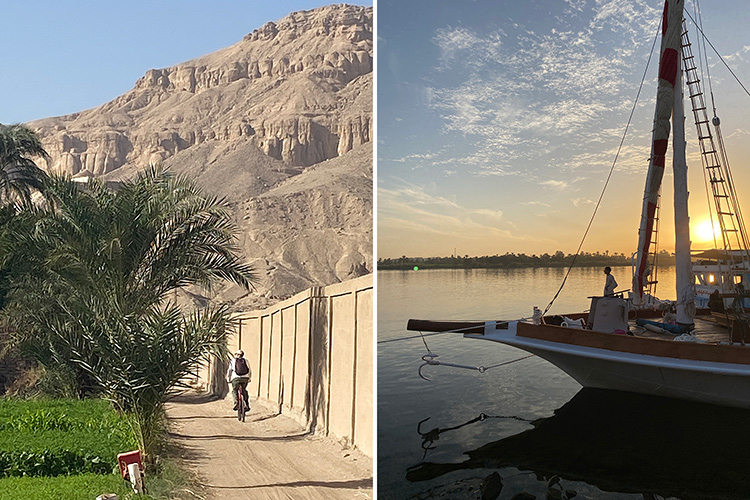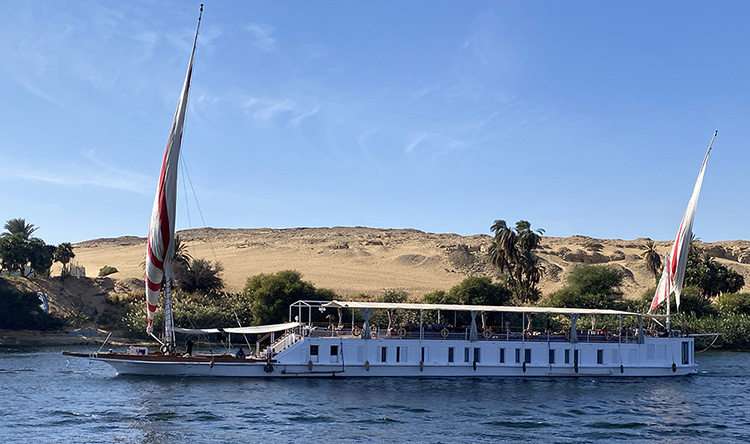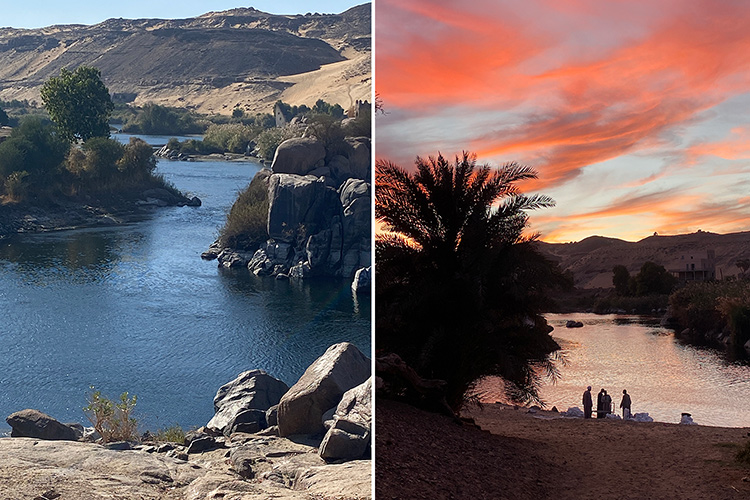ENTER YOUR EMAIL TO RECEIVE OUR WEEKLY NEWSLETTER
A Landscape Painter Cruises the Nile
And discovers temples, monuments, tombs, and timelessness on a river with a surface so smooth, it seems motionless
By Maddine Insalaco

Brushstrokes: Elephantine Island, one of the author’s Nile cruise paintings.
. . . . . . . . . . . . .
May 8, 2023
The sun was setting as land came into view over the southeastern Mediterranean. From the plane’s window, I spotted a solitary lotus shape fanning out toward the shore, from which a pink ribbon squiggled away for miles before vanishing in the blue-grey dusky landscape. Although a stranger to this territory, I knew right away what I was looking at. The Nile. Long thought to be the world’s longest river. The inspiration for my journey.
Last November, at the end of our working season as landscape painting teachers and food tour organizers in Italy, my husband Joe Vinson and I spent three weeks in Egypt. As was our typical practice, we planned little in advance—to allow us to be spontaneous and flexible as possible. The one exception was booking a five-day cruise.
I had harbored a fantasy for a long time about traveling down the Nile on a sailboat. I wanted a private experience of the legendary landscape—and, ideally, to paint it. I also hoped to observe local life along the river, which I understood to have changed little over the centuries.
No other country in the world has been shaped by a single element of geography as much as Egypt has been by the Nile River. In many ways, Egypt IS the Nile. Silt deposited from centuries of annual flooding made agriculture and settlement possible. The river’s easy navigability allowed commerce to flourish, which generated wealth to build great cities and a rich material culture. From the pre-dynastic period through to the present, the Nile has nourished 6,500 years of civilization.
Our adventure began with a few days in Cairo—a congested, densely populated modern metropolis of 20 million. It has an organized chaos, which we found exciting. A bit like Italy’s Naples on steroids. Even for seasoned New York jaywalkers, crossing Cairo’s streets can be death-defying. This, along with endless construction and lack of riverside green spaces, discouraged us from strolling along the Nile.
In Cairo we had our first exposure to the high level of security the Egyptian government has implemented to protect tourist monuments, hotels, and infrastructure. Military personnel with guns, document checks, and road blocks were everywhere. After an initial uneasiness, we actually found these measures reassuring.
The context for the trip was provided by a visit to the antiquities collection at the Cairo Museum, followed by a day in the historic center and market. Old Cairo is full of beautiful historic mosques and architectural treasures. The 14th century Khan el-Khalili bazaar is a fascinating maze of narrow streets and shops, but with few exceptions the merchandise is limited to tourist souvenirs, mass-produced clothing, and home goods from China.

Egypt, daytime and twilight: A morning spin along the Theban Hills, near the Medinet Habu Temple in Luxor; sunset on the Nile.
. . . . . . . . . . . . .
We hired a private driver for a day to take us to the pyramids. At the recommendation of a friend, we reserved a table at the 9 Pyramids Lounge inside the Giza Plateau archeological zone, where at breakfast we enjoyed a view of the pyramids removed from the tourist masses. The crowds discouraged us from lingering, so after taking photos we moved on to Saqqara, the necropolis of ancient Memphis—not as well-known as Giza, but far more interesting. Drawn to the site by the step pyramid of Djoser, we explored buildings with relief sculpture and painted tombs, interspersed with indecipherable hieroglyphs. Most extraordinary was a catacomb for mummified sacred bulls. Unhurried and alone, we felt that we’d connected with the soul of pharaonic Egypt.
The Nile flows south to north—an uneven vertical axis dividing the country and perpendicular to the east-west path of the sun. For the ancients, this relationship formed an organizing principle for community planning. The river’s east bank became associated with the light of the rising sun and life; the west with darkness and death. Towns and temples were located on the east side of the river, cemeteries on the west.
The setting of Luxor, the ancient city of Thebes, is typical of this arrangement. On the west side of the Nile, travelers come to visit the tombs in the Valleys of the Kings and Queens, on the east the Temples of Karnak and Luxor, where the modern city sprawls along the river. Bucking the usual tendency, we booked a guesthouse in a farm village on the west bank—and, because we were far from the noise and confusion of the city, we had our first experience of timeless Nile culture.

A painterly view. Maddine Insalaco’s Theban Hills Towards the Valleys of the Queens and Kings.
. . . . . . . . . . . . .
The town of Medinet Habu is located three miles from the Nile, where the landscape abruptly splits between cultivated fields and desert. The land is irrigated by channeled river water, as it has been for centuries. Small farm plots are neatly ordered. Tractors and all forms of mechanized support are absent. Plowing, seeding, and harvesting take place by hand, with only donkeys for assistance. Carbon footprint zero! Here is a pre-industrial time warp.
Our accommodation overlooked the ruins of the temple of Ramses III, towards the Theban hills. The view—a landscape artist’s dream. Each day I woke up before sunrise, climbed to the roof, and painted. Nothing I had read suggested that I would find myself in this painting paradise, or that I would awaken to the spectacle of hot air balloons drifting over me. Tourists are bused in from the east bank for a ride each morning and disappear by 7:00 am.
We rented bicycles to visit the Temple of Hatshepsut in Deir al-Bahari and the Valley of the Kings. For two days we sped along the twisting roads, enjoying the landscape and the grand scale with which the ancient Egyptians honored their dead rulers.

Pleasure barge: A dayabiya—one of several cruising along on a Nile flotilla.
. . . . . . . . . . . . .
We left Luxor with regret, but were excited at the prospect of our upcoming Nile cruise. We’d chosen the tour operator Nour el Nil because it hosts passengers on traditional dayabiyas. Originally built to carry aristocratic and royal families, a dayabiya is a pleasure sailboat commonly used in the 19th century. The vessel is small, with a maximum of 12 rooms. The deck is open and elegantly furnished with comfortable chairs, sofas, and tables, shaded only by a white canvas roof. It has a shallow draft, so it can dock along the river in places inaccessible to oversized tourist boats.
For the next five days, I was able to get close to my dream of the Nile. We sailed south for 100 miles from Esna to Aswan, stopping to see sites on an itinerary that included guided tours of temples, monuments, and farms, plus activities like hiking and swimming. Our days were not over-organized, so we had plenty of down-time. I spent my hours observing the Nile.
Unlike other rivers I’ve studied up close—like the Tiber, Thames, Seine, and Hudson—the Nile flows slowly, gently, and quietly, the surface so smooth it seems motionless. We drifted past villages whose rhythms and rituals belonged to remote ages. The landscape is mostly undeveloped and natural. There was a timelessness to it all, especially at sunrise, when light and color spread across the earth and water, that was indescribably moving.
Unfortunately, painting was not an option, as we were never stationary long enough, and, while lovely, the riverside views did not inspire me.

Shoreline vistas: As seen from Elephantine Island—free of paved roads, cars, or swarms of tourists.
. . . . . . . . . . . . .
The restless New Yorkers in us started to feel monument fatigue. We were anxious to move on to an un-touristy spot where we could relax and paint for the last week of our trip. After some focused research, we chose Elephantine Island, across from the ancient city of Aswan along the Nile. It was the unexpected highlight of the trip.
Aswan is commonly known for the two 20th century dams built to regulate flooding and generate electricity. It is also the point of departure to visit the iconic rock-cut temples of Abu Simbel. Most interesting, however, are the cultural differences between Aswan and the rest of the country. The major southern city closest to Sudan, it has a distinctly African vibe. The population, predominantly Nubian, has far less of the aggressive mercantile attitude of its northern Arab neighbors. The atmosphere is easy and relaxed.
Elephantine Island is technically part of Aswan, but its relative inaccessibility has saved most of it from the ravages of development. Only a five-minute ferry ride across the Nile from central Aswan, the two places could not be more different. There are no cars, taxis, or paved roads. The only way to move about is by foot. Shops sell basic necessities; tourist souvenirs are rare. There are scatterings of family-run restaurants. The typical accommodations are simple guesthouses, most of which have their own boats for collecting and ferrying clients back and forth to the mainland. Happily for us, these features discouraged many tourists, so most of those we met were friendly locals.

Capturing the view: Joe Vinson with a portable easel on his lap, painting on Elephantine Island.
. . . . . . . . . . . . .
We stayed in a guesthouse on the western side of the island, near the archaeological zone. It had a gorgeous view across the Nile to the desert and was just a short walk to a river-scape of tiny islands and giant rocks that looked coincidentally, like herds of bathing elephants. Once again, we’d stumbled into a painter’s heaven. There we enjoyed our most intense and magical experience of the Nile.
I set out each sunrise with my paint box, planted myself on the pink granite rocks, and watched the river life awaken. Birds, water creatures, fisherman, laborers, water taxis, all moving about in a daily ritual. After a few hours, I returned to the guesthouse for breakfast with my husband. We idled away the midday, and both returned later to the river to paint.
There is something sublime about late afternoon on the west side of Elephantine Island. Everything takes on the golden cast of the setting sun. Individual forms are no longer distinct but unified into a larger whole by a diaphanous veil of light. A sense of peace, order, and harmony pervades the landscape. At this point each evening, feluccas appear on the river carrying tourists for a sunset sail. These small, single-sail vessels have been present on the Nile for centuries and are the quintessential symbol of river culture.
We became completely absorbed in our painting routine in this island oasis. Of all the places we visited in Egypt, Elephantine Island corresponded most closely to our fantasies of what life on the Nile could be. We were reluctant to leave but were heartened by the fact that we’d found what we’d been looking for—which in itself was amazing. Having had this experience, it will be easy to return in the future.
Maddine Insalaco is a painter who usually divides her life between New York and Tuscany, where she organizes landscape painting workshops and gastronomic tours with her artist husband. Instagram: @maddine_insalaco.
You may enjoy other articles by Maddine Insalaco:











